| Zen Outfitters Furled Leader |

|
Zen Outfitters Furled Leaders
I
am a convert to furled leaders. I've used tapered mono leaders, knotted leaders constructed of various weights of filament.
I've used braided leaders, I've used other systems as well. For the kind of fishing I do, nothing works
better than furled leaders. Furled leaders are made of a bunch of strands of very fine filament or
thread wound together to form a single leader. They come in various lengths, from 3 feet to 8 feet long. I've
found that the most useful all-around lengths are between 4 and 6 feet, with the length dependent on the length of the rod
you use. The weight of the leader is matched to your line, so you buy the leader to match your line weight.
Furled leaders attach to your fly line with a loop to loop connection. Then, you attach 3-4 feet of tippet
onto the end of the furled leader, and you're ready to go. The better ones have a tiny ring on the end, to
make tying on tippet easier. Why do I like furled leaders? Because they improve my casting. They
really help you "turn over" a fly, especially when casting short distances with a small amount of fly line out.
The furled leader does not have any "memory" and won't kink or "slinky" like other leaders.
Unlike regular monofilament leaders, the furled leader acts almost like a mini fly line. When fishing a short line,
the furled leader has enough mass to help keep the weight of the fly line from "retracting" your fly.
(Most of us who often fish with a short line have had the frustrating experience of seeing the weight of the fly line
pull the leader and tippet back toward you, stopping only when the fly catches in the tip guide.)
For long casts, the furled leader "turns over" a fly better than any other I've used. It also
allows you to use a long, lightweight tippet and still retain the ability to lay out the fly. Furled leaders
are durable, and last longer than other types. I have never broken one, and they don't seem to ever wear out either. I have found that, with some types of furled leader, they tend to sink.
One trick I've found is that if you rub a little silicone mucilin dressing on them every once in a while, it enhances
the leader's floatability. Cleaning them every time you clean your flyline is also a good idea. Up until recently,
my favorite furled leaders were from Feathercraft. Now, however, I prefer those from Zen Outfitters.
I’ve
used various types of furled leaders, including home made leaders and leaders from various companies. For
several years, I happily used furled leaders from Feathercraft. Then, I
was introduced to a new style furled leader by Jaime Chriswisser at Zen Outfitters.
He offered to let me try one of his furled leaders and see if I liked it. I figured that all furled
leaders are pretty much the same, but I also couldn’t really pass up the offer of free swag, so I took him up on the
offer of a free leader. As it turned out,
I liked the Zen leaders a lot more than I thought I would. I liked them so much, in fact, that I purchased
a bunch of Zen leaders to replace the Feathercraft leaders I already had on all of my reels.
Jaime made them in various lengths to match the rods and lines I would be fishing with.
Why do I like them so much that I would pay to replace the perfectly good furled leaders I already have?
First off, I like the way that they cast. They have a very supple quality to them that is superior
to that of the other leaders I have used. On the Zen Outfitters website, they point out that Zen
leaders are made from uni thread. I actually don’t know what uni
thread is, but I can say from experience that it appears to be superior to whatever it is that Feathercraft
and Blue Sky are using to construct their furled leaders. The Zen leaders allow for softer, more delicate presentations when dry fly fishing. The leader
lays out the fly with less disturbance to the water. This is especially apparent when I am fishing really
small flies. Even though the leader is softer and more supple, it still has enough “backbone”
for short line fishing with just the leader and a foot or so of fly line.
The other thing I really like about the Zen leaders is that they float. With other furled leaders
I have used, I have had to regularly use mucilin to coat the leader. Without
the mucilin, the leader tended to sink. The Zen leaders have some sort
of floatant built into the leader. Whatever this floatant
is (it’s a secret formula I guess) it works well, and appears to be permanent. I’ve been using
the Zen leaders for months now, and have not had to apply any floatant to keep them from sinking.
Because the Zen leaders float so well, they also don’t pick up water as much as the others I’ve used, which
reduces any spray when casting.
Speaking
of floatants, I also got to test out Zen’s proprietary floatant.
It was kind of a waxy substance that reminded me a bit of lip salve. At first, I didn’t like
it at all. It kind of gummed up my flies and didn’t work as well as I thought it should.
However, after a while, I realized that I was using way too much of it. (I’m used to
using Loon Aquel, and was putting on as much Zen floatant as I would
the Aquel.) Once I figured out that I needed only a very tiny amount
of the Zen floatant, I was much happier with it. It resisted water logging
as well as anything I’ve used, and I found that I didn’t need to re-apply it very often.
Zen Outfitters Furled Leader Page
Patagonia Vest Pack
This is my new "big pack" for extra long days and light overnight trips.
I used to use the Fishpond "Shooting Star" pack for this purpose (see the
review of the Shooting Star below) but the Patagonia vest pack is superior to the Shooting Star in many ways.
The best thing about the Patagonia Vest Pack is the pocket placement.
Rather than have all the pockets stacked up in the center, the pockets are arranged along the sides, like a vest. I
find this arrangement to be much more comfortable and easy to access. It's also significantly lighter.
My pack is a slightly older model and has 1680 cubic inches capacity.
The newer one is slightly smaller at 1525 cubic inches. Still, it's big enough to hold your waders, and everything
else you might need for a day of fishing far from the trailhead.
The pocket sections of the pack detatch with buckles, and clip together
with an accessory strap so that you can use them seperate from the pack bag. I don't find myself doing this very much,
however. I don't really notice the pack bag when I'm fishing.
It's a very nice piece of gear. Patagonia has done a great job with
the design of this vest pack. It has everything you need, without being cluttered with unncecessary features.
| Patagonia Vest Pack |

|
Kaenon Polarized Kore Sunglasses with C-50 Lens
I bought these sunglasses for only one reason. They allow the most
light transmission for any polarized sunglasses that I know of. Kaenon sunglasses are available with a number of
different lenses, and the C-50 lens is copper colored (hence the "C") and allows 50% visible light transmission. Typical
polarized fishing sunglasses allow about half that amount of light. For example, my Smith/Action Optics sunglasses
with a polarized, photochromatic "all conditions" lens allows a maximum of 28% light transmission.
So why am I looking for sunglasses that don't block the sun? It's
because when I fish, I need the polarization feature to cut the glare and allow me to see into the water, but I don't
often need a really dark lens. I don't fish on white sandy beaches or other super bright places. I typically am
fishing on mountain lakes or streams. It's sometimes shaded, sometimes cloudy, and I sometimes fish until the evening.
A lens that blocks 50% of visible light is fine for these conditions. In fact, I've found that my depth perception and
general vision tends to be better if my sunglass lenses aren't too dark.
Like a camera lens, your eye focuses more easily if the pupil is not too
dilated. With darker sunglasses, I would often remove my sunglasses when threading hooks and tying
on flies. I could just see more clearly and focus better without them. With the Kaenon's bright lens,
this is no longer an issue.
The quality of these lenses is superb. They are made from a new
plastic material that Kaenon calls SR-91. It's lightweight, strong, and has excellent optical clarity. I am pretty
sure that the lenses are made from the same material that the new Julbo mountaineering lenses are made from, (that Julbo calls
"NXT".)
In the light, the C-50 tint lenses just seem to sharpen everything up, and they are just dark enough to be soothing to the eyes. Even when the
sun is shining brightly, I don't experience any eye fatigue from fishing all day.
The frames are very comfortable and reasonably light weight. I
can wear them all day long without noticing that I have them on. The sunglasses come in three different
lens sizes. I just ordered a medium, and it seems to fit me well. If you've got a small or large face, you
have the option of buying the Kore with small or large lenses.
They came with a nice case and a soft bag.
Overall, I am very pleased with the Kore sunglasses. I bought them thinking that I
would use them only in low light situations such as dawn and dusk. However, they work so well that they have
become my primary fishing sunglasses. About the only thing I don't like about them is the price. At around $200,
they are pushing the edge of what I'm willing to pay for a pair of sunglasses, no matter how great they are.
| Kaenon Kore |
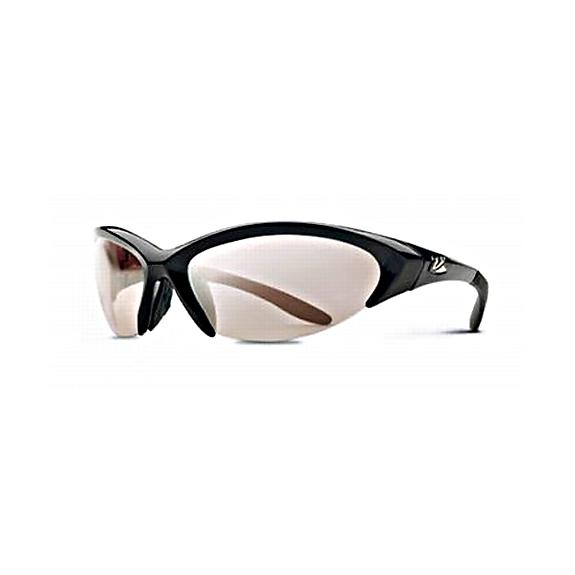
|
Korkers Cross Current Wading Boots
Korkers have been around for a while. Their boots are built on the design of having
a single boot with interchangable soles.
I've been intrigued by the concept of their interchangable soles, but folks I talked to had some
issues with the soles coming off when they weren't supposed to, and the boots were relatively heavy. However, Korkers
redesigned their boots and the sole attachment mechanism not too long ago, and I'd heard enough praise for the new Korkers
boots that I finally decided to buy a pair.
I have to say that I really like these boots. I bought the Cross Current model, which is
the lightweight boot of their line up. I tried on the other two heavier boots, but the extra weight was readily apparent,
and they didn't seem to offer a whole lot more support. Because I plan on using my Korkers boots primarily for fishing
trips that involve a lot of hiking, light weight was an important consideration.
The soles are pretty easy to switch out. With the small tool provided with the boots,
changing soles takes about a minute per boot. Initially, it took longer than that, but with practice, it has become
much easier. Also, I've found that when I forget or lose the tool, I can use a car key, a fish-hook file, or a
screwdriver blade from a swiss army knife in place of the tool provided.
These boots are terrific for days that involve both fishing and hiking. The boots
are very comfortable to hike in. With the lugged hiking sole installed, they have traction much like any other
hiking boot. They are comfortable too, and I've worn them on days where I've hiked over ten miles on and off trails
with no problems. I typically wear them with waterproof goretex socks (sealskinz) over my wool hiking socks
to protect my feet from getting wet.
I've waded using the felt soles and studded felt soles, and both provide wading traction equal
to any other soles I've used. A bonus of the interchangable sole design is that the rubber perimeter that surrounds
the felt sole provides purchase on dirt and grass that is superior to an all felt sole, which can be treacherous when hiking
and scrambling.
I haven't used these boots long enough to come to a definitive conclusion as to durability, but
so far, they've held up very well, with not signs of undue wear.
I bought these boots primarily as boots for use whe I planned on doing a lot of hiking.
However, they are so comfortable and capable that they are becoming my all-around boot of choice. Their versatility
is unequaled by my other boots, and they seem just as effective for wading as any of my boots that don't have the interchangable
sole feature.
I am also considering the idea of using them as a single boot solution for long backpacking trips. So
far, I have no complaints as to their performance for hiking or wading, so my Korkers may ultimately serve the dual
purpose of both hiking boot and wading boot on my backcountry fishing trips.
| Korkers Cross Current Boots and Studded Felt Soles |
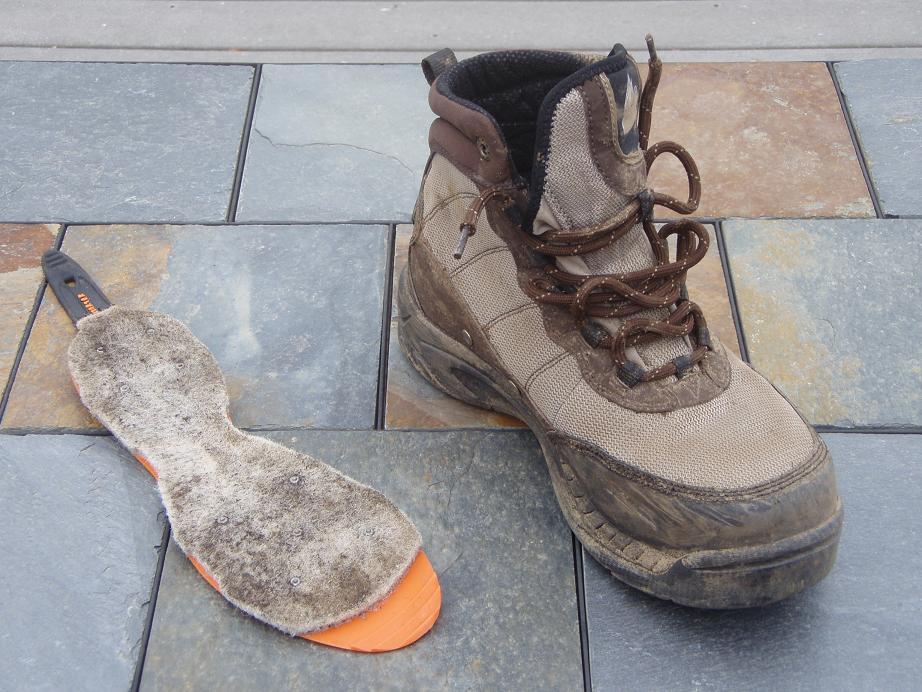
|
Hodgman TAC (Total Allowable Catch) Waders
These waders have a zipper in them that goes from crotch to chest.
At first, I thought that a zipper in a pair of waders made about as much sense as screen doors in a submarine. I really
didn't care what the advertising said, I figured that the zipper would leak eventually. However, I've been using these
waders for over a year, and I haven't had a single drop of leakage from the zipper. Having the zipper does make it
far more convenient when you need to relieve your bladder. No need to mess with suspenders, and roll the waders
down; just unzip and you're "good to go."
The zipper is pretty much the only frill on these waders. Otherwise,
they are all no-nonsense, with only the functional basics. They have comfortable neoprene booties, shaped to fit
the left and right feet, simple webbing adjustments at the waist in lieu of a belt, a simple but comfortable suspender system, gravel
guards, and a couple of small pockets on the inside of the chest.
The fabric is made from Hodgman's proprietary waterproof/breathable fabric, Hortco-tex.
I have no idea what Hortco-tex is, but it is perfectly waterproof, and breathes pretty well (although not quite as well
as the Gore-tex waders I've used.) What I can say about this fabric is that it is extremely, uncommonly durable.
I have seriously abused these waders on rocks and sticks while wading and bushwhacking and they still appear almost as
new. They are excellent for those days when you're going to be doing a lot of "Rambo" fishing, as they
can take a real beating.
These are very good waders, and at under $200, they are pretty reasonably priced.
Given their durability and functionality, I will likely be still wearing these waders five years from now.
| Hodgman TAC Waders |
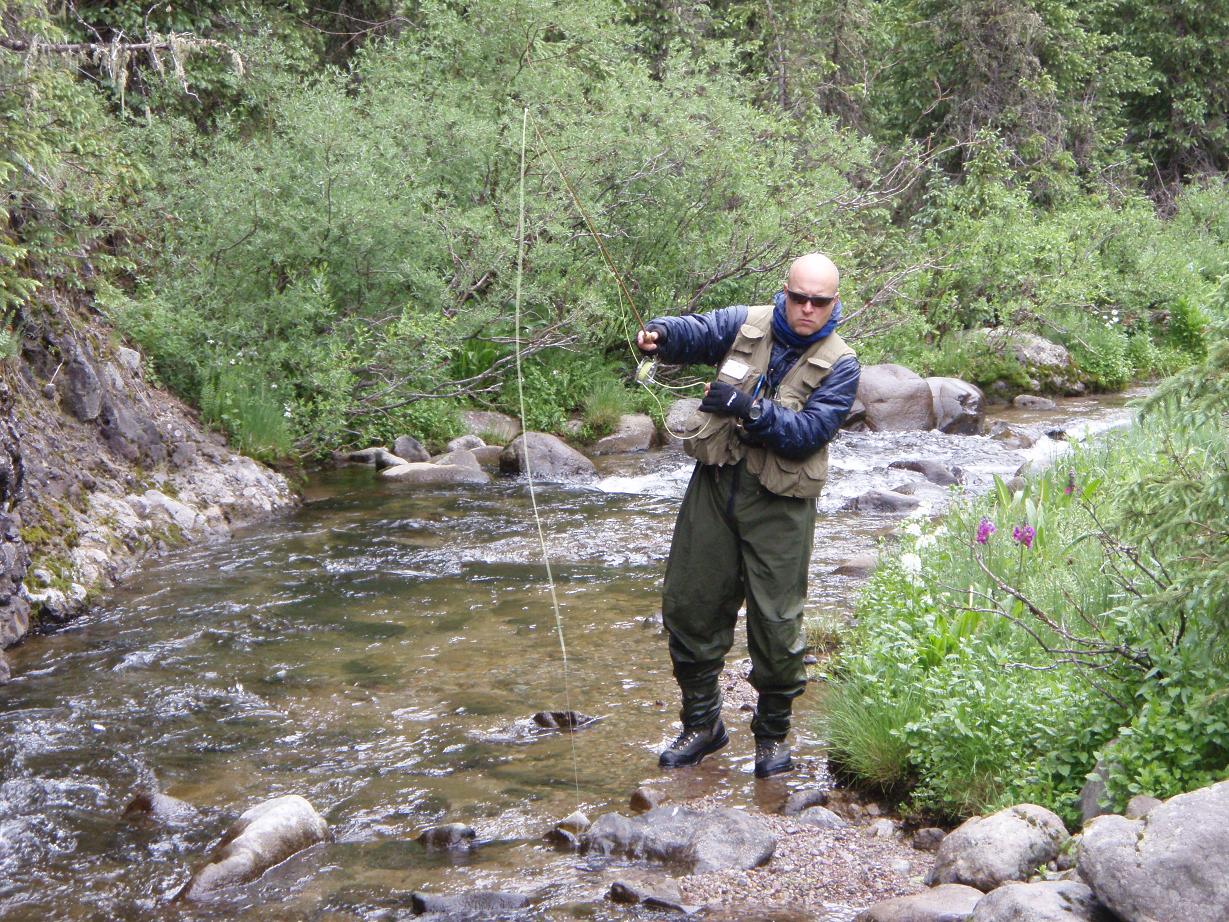
|
LL Bean Rapid River Vest Pack
I own quite a few vests and fishing packs. I have three larger packs, and three vests,
and a couple of small shoulder packs. The Rapid River Vest Pack is the one I use more than all the others combined.
It has a number of features that make it my favorite. First off, it has excellent capacity. The backpack portion is
expandable, and will hold enough stuff for a whole day of fishing. You can put your lunch, a 3 quart water bladder,
rain jacket, and other assorted necessities in this pack with a bit of room to spare.
The front part of the pack, which is designed to hold your fishing tackle, is very well
thought out. There are two large pockets sized to hold big fly boxes, and other pockets to hold tippet, strike indicators,
etc. There is enough storage space to carry everything you might need to catch fish. There are a couple of
built in retractable "zingers" to secure your nippers and hemostat. The best thing about the front gear storage
is that it is distributed widely across your torso, so that it doesn't create a big protruding lump on your chest that
interferes with casting and being able to see your feet.
Even fully loaded, this vest/pack is very comfortable. The combination of the vest, shoulder
straps, and hip belt distributes and controls the weight better than anything else I've ever used. The hip belt, in
particular adds to the comfort of the pack, both with weight distribution and also lending some back support for
long days on the river.
The vest provides decent ventilation for a pack of this type. I use it in the heat
of the summer with no issues.
As much as I like this pack, it isn't quite perfect. First off, the back pack part could
be a lot bigger. It's not quite big enough to comfortably stow neoprene footed stocking foot waders. Certainly,
the weight bearing features of this pack make it easily capable of incorporating a much larger capacity back
pack. If the size of the back pack were doubled, it could then hold your waders for the hike in, along with everything
else needed. This seems like a serious design oversight to me. I don't know why the designers did not think the
make the pack large enough to stow waders.
It's also a bit heavy and bulky when compared with a regular vest. I wouldn't want to pack
this in on a long backpacking trip. It just weighs too much and takes up too much space to be a good backcountry fishing
vest.
The other shortcoming if the pack is perhaps an inevitable result of its design. It tends
to get wet when deep wading. The pockets are not placed particularly high, and the waistbelt and lower part of the backpack
tend to become submerged when wading much more than waist deep. To counteract this, I use waterproof fly boxes,
and store any water-sensitive items (like my lunch) in waterproof ziplock bags.
Overall, however, I really like this pack. For long days on the water, it's hard
to beat. At under $100, it's also a bargain.
LL Bean Web Site
| Rapid River Vest and 8x Waders |
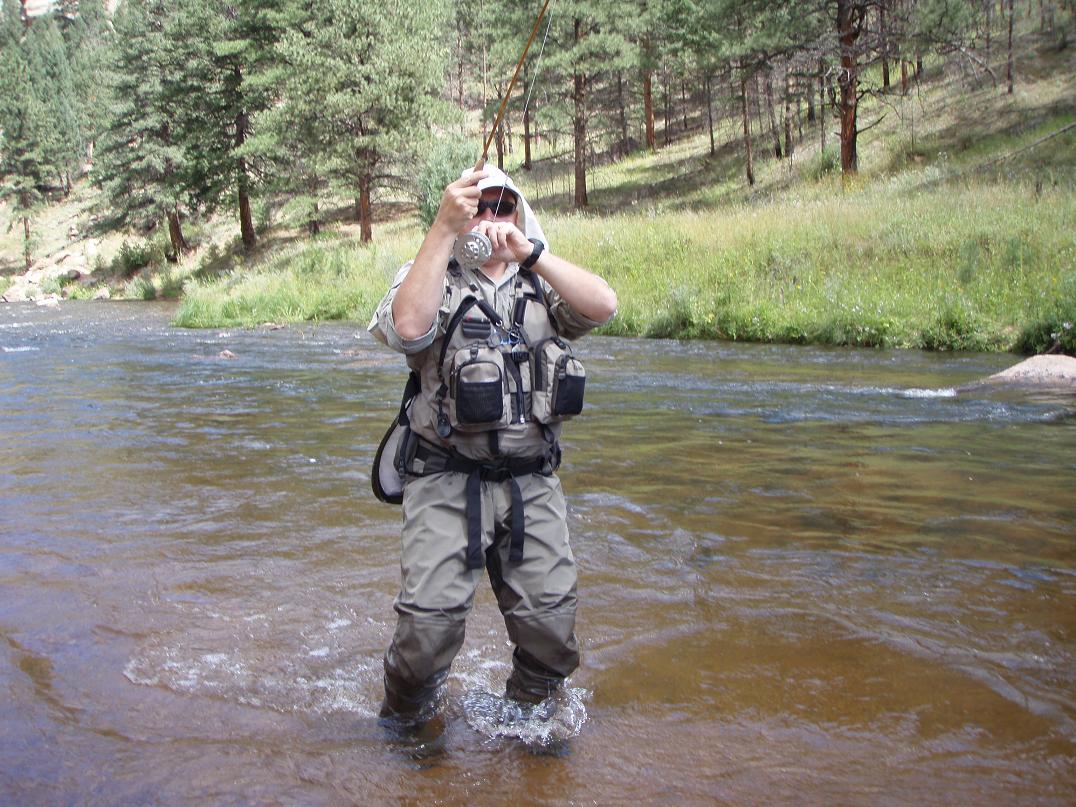
|
Cloudveil 8x Waders
I was familiar with Cloudveil before I even was aware that they made fishing gear.
I have used their excellent climbing/backpacking clothing over the years, and have been consistently impressed by the
quality of their offerings. So, when it was time for some new waders, I decided to give their 8x waders a try.
Fit of the waders is good, with excellent articulation in the knees. Mobility is very good,
without much "bagginess" and loose fabric. There are two large pockets on the chest, with water resistant zippers
(that do a good job of keeping out splashes, but won't resist a full-on dunking.)
There are elasticized drawstrings at the top of the chest that help to reduce water inside
the waders if you go under. (I always tug on these to tighten them a bit if I'm about to wade a particularly
treacherous section of water.)
Breathability is very good. They use Gore-tex fabric, which, in my experience, breathes
better than any of the other wader fabrics I've used. The top portion of the waders is made of a lighter weight material
that easily rolls down in hot weather.
The wader fabric has proven to be very durable, and have stood up to pretty heavy abuse
(both wading and bushwhacking) without a leak.
There is some room for improvement, however. The built in gravel guards are made of a stretch
woven material with a soft, fuzzy face. This soft material collects burrs and snags fish hooks. The plastic buckles
used on the suspenders don't seem to be all that durable. I've managed to break two of them so far.
The 8x is also a bit on the heavy side. There are lighter options available if you're
going to be using them for backpacking/fishing trips into the backcountry.
My biggest concern with these waders, however, is the durability of the neoprene booties.
The seam tape has come loose both on the outside and the inside. I've been able to mostly stick the outside tape back
on with seam-grip glue, but the inside seam tape is pretty much trashed.
I haven't experienced any leakage so far, but I'm worried that it's not long before the seam
tape failure compromises the waterproof integrity of the booties.
I feel that in waders of this price range, I really shouldn't have to be worrying about this
sort of thing.
But for the seam taping issues, these are outstanding general purpose waders. My ultimate
verdict on them, however, will depend mostly on whether the feet maintain their water-resistance, and given the state of the
seam tape, I'm somewhat pessimistic on this issue.
Cloudveil Web Site
C&F Design Waterproof Fly Boxes
These boxes have a number of advantages. The first is that they are waterproof. When
I'm wading, I take tumbles into the creek more often than anyone else I know. I guess I'm just clumsy, or too dumb to
recognize when the water is too treacherous for safe wading. After a dunking, it's nice to know that your flies are
all safe and dry and that you don't need to worry about drying them all out to prevent your hooks from rusting and hackles
from mildewing. likewise, I can wade as deep as I like and not have to worry about submerging my fly boxes.
The second thing I like about these boxes is the micro-slit foam. I haven't found
a more efficient way to carry flies. You can fit a ton of them in the box, and they are secured in such a way as
to not crush their hackles.
The third thing I like about these boxes is their flexibility. You can set them up with
all sorts of inserts, so that they can carry tons of smaller flies, or fewer huge streamers, or a combination of both.
Also, there is the option of adding a center divider than increases the capacity by a third. I haven't
used any other fly boxes that allow me to carry so many flies in a single box. I can carry all the flies I
would ever use on any fishing trip in just two large boxes.
The only downside to these boxes is that they are a bit heavier than foam boxes. However,
their greater capacity offsets this disadvantage somewhat, and I don't know of any foam boxes that are waterproof.
| C&F Designs Waterproof Fly Boxes |
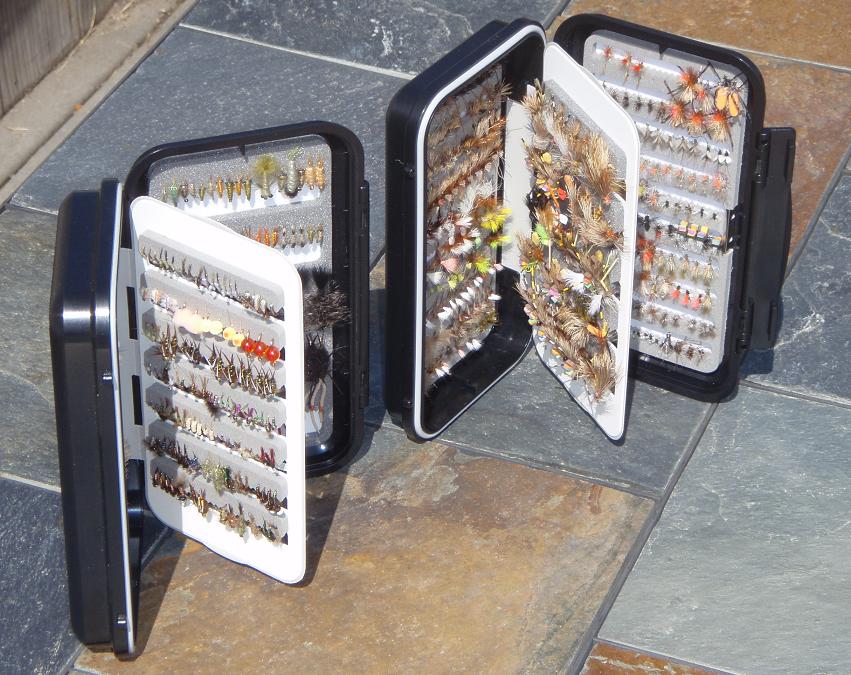
|
| Fishpond Shooting Star Pack |
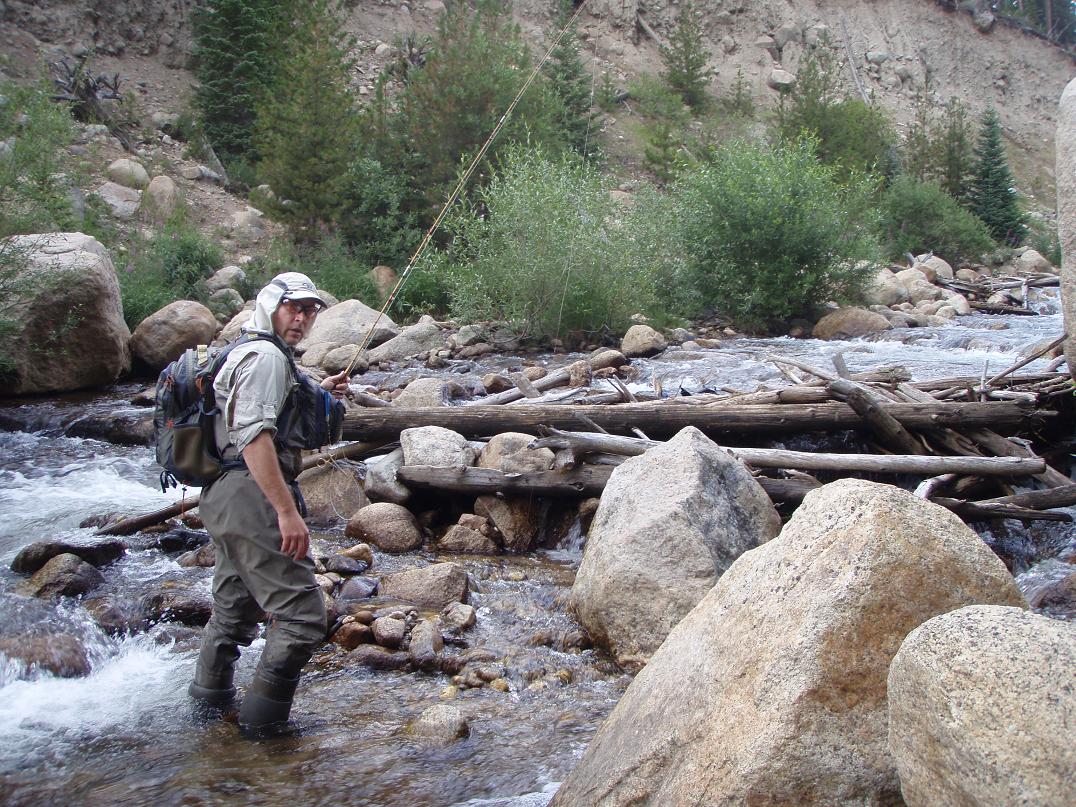
|
Fishpond Shooting Star Chest/Backpack
This pack's outstanding feature is that the backpack is large. It has a 1750 cubic inch
capacity, which means that it is big enough to hold your bulky waders, your lunch, spare clothing, and everything else you
need for a long day out. There are other fish packs out there with even more capacity, but they tend to have heavy,
stiff frames that make them more suited for load hauling rather than fishing. The Shooting Star is a large pack that
you can actually wear all day while fishing and not be put out by it.
It's reasonably comfortable when loaded. It has a simple webbing strap that functions as
either a hip belt or can be fastened to the chest pack to keep the bottom of the chest pack from flopping about. I've
found that when carrying heavier loads in the backpack, the strap is best utilized as a hip belt.
On the down side, however, the chest pack is of a design that I really don't care for much.
It is a great series of pockets, one stacked upon the other, that expands, accordian-like as you fill them. When fully
loaded with several fly boxes and all the other accoutrements of fishing, the chest pack sticks out so far as to
be rather clumsy. I really wish that it had a different pocket system, as I really dislike this arrangement.
The chest pack can be detatched from the pack and used separately, with the strap either hanging
from your neck or slung over a shoulder. This is nice if you are fishing "up and back" as you can leave the backpack
along the trail and just use the chest pack for fishing, returning at day's end to retrieve the backpack.
In spite of its faults, I used this pack a fair amount because I often hike considerable distances to
get to my fishing destination. This pack is of adequate size to allow me to carry my waders in the pack so
I don't have to hike in them. However, I finally switched from the Shooting Star to the Patagonia vest pack. The
Shooting Star has a somewhat larger capacity backpack, but the Patagonia pack is large enough, and I really prefer the pocket
lay-out of the Patagonia version.
| Fishpond Shooting Star Fishing Pack |
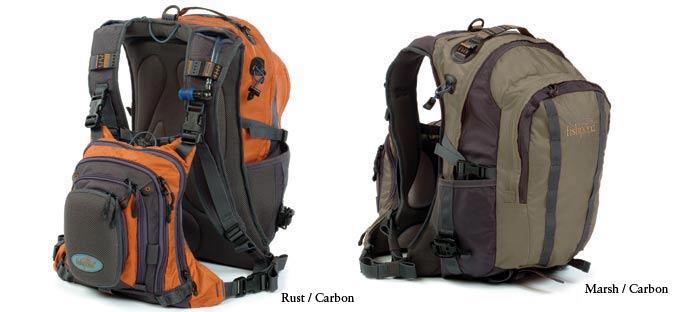
|
Scientific Anglers L2L Reconnect Leaders
The L2L Reconnect leader is a pretty cool idea. You fasten a connector on the end of your
flyline, and then you can change leaders by attaching a L2L leader to the connector with a simple twist. No need for
nail knots or loop to loop connectors for attaching leaders to fly lines.
The big advantage of this system is that it allows you to easily change from a dry fly to
a nymphing rig, and back again by simply changing leaders (a process that takes about 30 seconds or so.) You can leave
your nymphing rig all tied up and ready to go at a moment's notice.
If you're fishing a dry fly along a shallow stream, and come across a deep pool, it's easy to
change out to a nymph to plumb the pool's depths. Just twist off the leader with the dry fly on it, and twist on your
leader with the nymph rig on it, and you're ready to go. Orvis and Scientific Anglers both sell fly boxes with inserts
specially designed to hold leaders when not deployed on your rod. You can just wind the leader around the insert
for tangle-free storage, then unwind it when you want to use it.
They really do work as advertised, and I used the L2L leaders for a while. I would still
be using them but for one truly annoying flaw: The connector constantly gets caught in my guides when I'm fishing a
short line. It's not a problem when fishing big water, but when I'm on small streams (which is where I fish most often)
I'm typically fishing with only 3 or 4 feet of fly line beyond the rod tip. In such situations, it seems like the L2L
connector is constantly getting stuck in my tip guide, whereas a knotted leader or a loop to loop connection simply slides
through.
This drawback finally became enough of a hassle that it outweighed the advantages of the
system, and I stopped using it. This by no means should imply that the L2L system is not a good one. It's quite
effective for any situation where you are casting a significant amount of line. In particular, for nymphing in lakes,
the combination of the sinking tip leader, coupled with the connector (which acts like a strike indicator) is very useful.
However, for my particular fishing style (which mostly involves short line casting on small waters)
the L2L simply didn't work that well.
| L2L Reconnect |
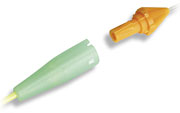
|
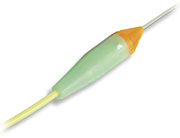
| Fusion Vest |
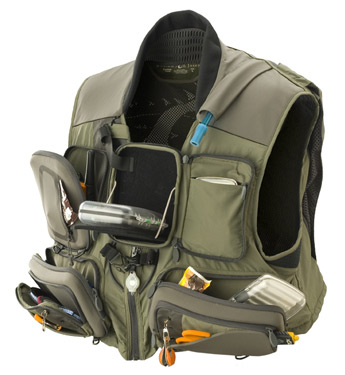
|
William Joseph Fusion Vest
I really wanted to like this vest. It is loaded with high-tech features, looks cool, and
is touted as combining the best features of a vest and a pack. However, I find that it really doesn't suit my needs
all that well.
First off, it doesn't carry very well when loaded. The vest is designed to carry a hydration
bladder in the back. However, I found that with anything over a half quart of water, the vest sags in the back and rides
up in the front. This tendency is exagerated the more stuff that you put in the back of the vest, and when fully loaded,
I find that it is not very comfortable. I tried to address this by addidng a wide velcro sternum strap that I could
use to tighten up the fit across the top of the chest. This improved things a little, but load carrying is still not
entirely satisfactory.
The pockets are rather high-tech affairs that seem to me to be somewhat overengineered for their
primary function of carrying stuff. The main pockets are stiffened with foam, so that they bulge even when empty.
Furthermore, they don't have side gussets in them, so when you make use of the full zippers, your gear has a tendency
to spill out the sides rather than be retained in the pocket.
One of the pockets has a very cool looking feature. It unzips and a small "table" folds
out. I guess that this is great for folks who want a flat surface to work on while fishing, but I've never once felt
the need for such a little table.
There are built in retractor/zingers for holding your nippers and hemostat, but they are
placed at the bottom of the vest rather than higher on the torso. I find that when using these tools, I'm
typically using them at or near eye level, so mounting them just above my waist doesn't make sense. Also the
little pockets designed to secure these tools don't hold them very securely, and they are prone to fall out and dangle when wading.
On the plus side, the vest has lots of storage compartments, and is cut pretty high, so
deep wading won't submerge the vest unless you go really deep.
Overall, however, I find that this vest doesn't have the simplicity or light weight of my
other vests, and doesn't have the capacity of a pack. It's really a fusion of the limitations of the vest and the
pack, with very few of the benefits of either.
| William Joseph Fusion Vest |
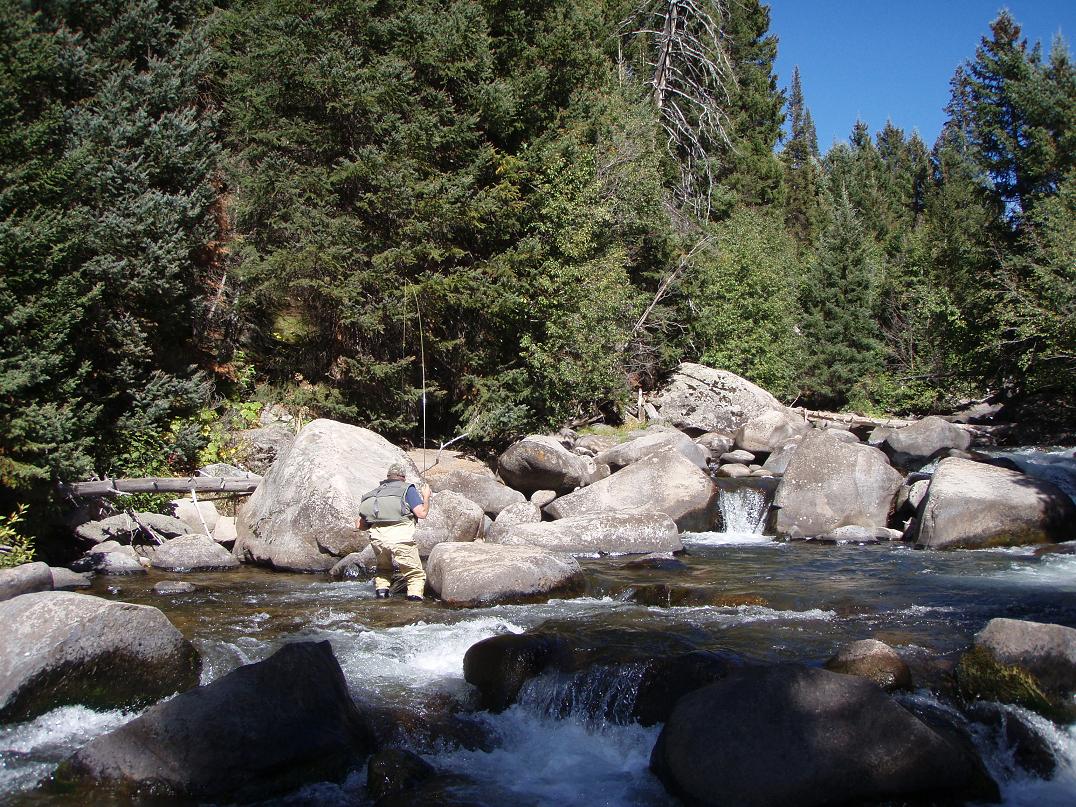
|
LL Bean Ultralight II Wading Boots
These boots have the best rubber soles I've used. The "stealth" rubber is made by Five-ten,
the same folks who make sticky rubber rock climbing shoes. These soles are siped (meaning that they have slits cut into
the lugs) like high-performance snow tires. In addition, they have metal studs in them for extra traction on slimy rocks.
All of these sole features combine to provide very good traction when wading; significantly better than my other
rubber soled boots (including other studded rubber soled boots.)
The boots themselves are very comfortable both for wading and for walking. I like
the plastic pieces that protect the ankle bones, and they provide excellent support, while not feeling overly stiff
or clumsy like some beefy wading boots I've used. They make excellent hiking boots as well as wading boots.
Durability is very good as well. There are heavier boots available, but I can't see why I would want to use them.
At 23 ounces per boot, the Ultralights provide excellent performance in a lightweight package.
| LL Bean Ultralight II Boots |
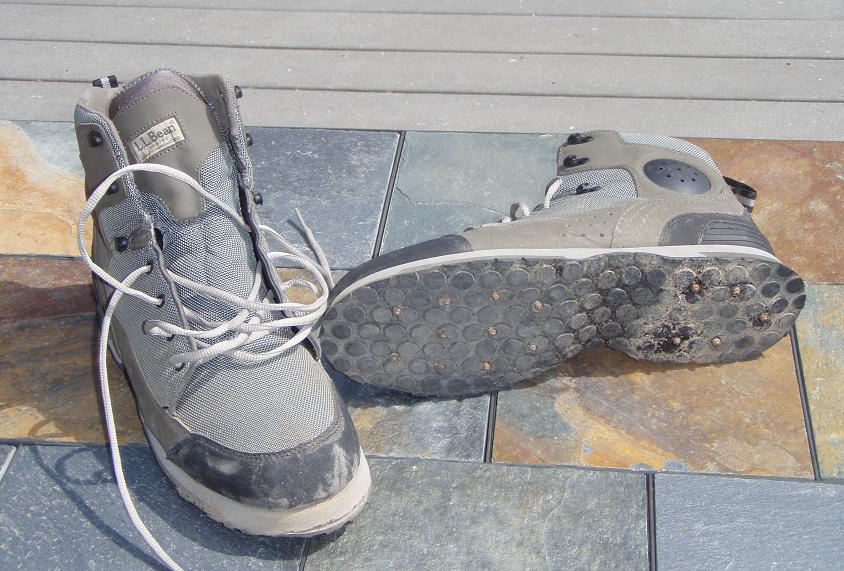
|
Galvan Open Back Reel
I own a bunch of reels, some more expensive than my Galvan OB, and some less expensive.
However, I don't think that any of my reels is the equal of my Galvan in terms of how smoothly the reel operates and how progressive
the drag settings are.
It is carefully machined, and just from handling it, you can tell it is made by folks who care
about quality. It's light, dependable, and has a simple elegance about it.
I now own two of these, and a spare spool as well. For trout fishing, I don't see any reason
to buy anything else in the future.
| Galvan Open Back Reel |
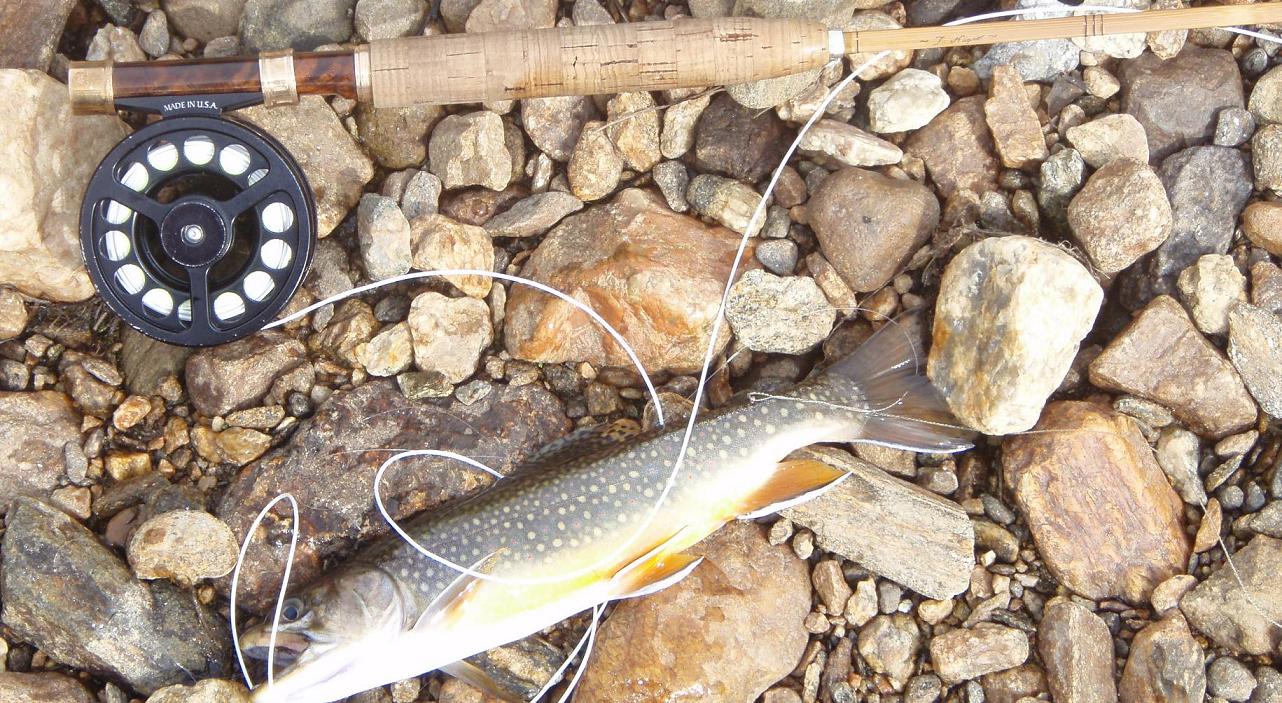
|
|

